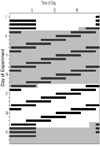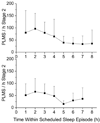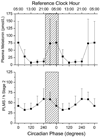Periodic limb movements in sleep exhibit a circadian rhythm that is maximal in the late evening/early night
- PMID: 21093364
- PMCID: PMC3052966
- DOI: 10.1016/j.sleep.2010.06.007
Periodic limb movements in sleep exhibit a circadian rhythm that is maximal in the late evening/early night
Abstract
Objective: Periodic limb movements in sleep (PLMS) show a time-of-night pattern, with most movements at the beginning of the night. Our study aimed to determine whether this pattern is due to an endogenous circadian rhythm, like that in the related movement disorder Restless Legs Syndrome (RLS).
Methods: Four healthy older adults with a screening PLMI>20 were studied in an inpatient forced desynchrony protocol with an imposed sleep-wake cycle of 20 h for 12 "nights," allowing separation of circadian and sleep homeostatic influences on leg movements. We recorded sleep polysomnographically throughout each scheduled episode, including left and right anterior tibialis EMG.
Results: PLMS in Stage 2 showed both a significant time-within-sleep pattern and a significant circadian rhythm. The circadian rhythm in PLMS peaked at the circadian phases when usual sleep onset occurs, preceding the evening rise in melatonin secretion.
Conclusions: In our subjects, the circadian pattern of PLMs expression was very similar to that previously reported in patients with RLS. This evidence for a circadian rhythm in PLMS has implications for treatment and provides direction for future studies of the pathophysiology of this movement disorder.
Copyright © 2010 Elsevier B.V. All rights reserved.
Conflict of interest statement
Conflicts of interest.
This is not an industry-supported study and did not test any investigational drug or device. Mr. Silva and Mr. Lowe report no conflicts of interest. Dr. Duffy reports that she has received research grants from Philips-Respironics, Inc. that are unrelated to the present work. Dr. Winkelman reports that he has received research support from GlaxoSmithKline and Sepracor; he is a member of the speakers bureau for Sanofi-Aventis and Sepracor; he is a consultant or member of an advisory board for Covance, GlaxoSmithKline, Impax Laboratories, Luitpold Pharmaceuticals, Neurogen, Pfizer, and Zeo.
Figures



Similar articles
-
The validity of the PAM-RL device for evaluating periodic limb movements in sleep and an investigation on night-to-night variability of periodic limb movements during sleep in patients with restless legs syndrome or periodic limb movement disorder using this system.Sleep Med. 2014 Jan;15(1):138-43. doi: 10.1016/j.sleep.2013.08.790. Epub 2013 Oct 31. Sleep Med. 2014. PMID: 24269130 Clinical Trial.
-
Immobilization tests and periodic leg movements in sleep for the diagnosis of restless leg syndrome.Mov Disord. 1998 Mar;13(2):324-9. doi: 10.1002/mds.870130220. Mov Disord. 1998. PMID: 9539348
-
Circadian rhythm of periodic limb movements and sensory symptoms of restless legs syndrome.Mov Disord. 1999 Jan;14(1):102-10. doi: 10.1002/1531-8257(199901)14:1<102::aid-mds1017>3.0.co;2-e. Mov Disord. 1999. PMID: 9918351
-
Why the worsening at rest and worsening at night criteria for Restless Legs Syndrome are listed separately: review of the circadian literature on RLS and suggestions for future directions.Front Neurol. 2023 Apr 27;14:1153273. doi: 10.3389/fneur.2023.1153273. eCollection 2023. Front Neurol. 2023. PMID: 37181571 Free PMC article. Review.
-
Polysomnographic features of idiopathic restless legs syndrome: a systematic review and meta-analysis of 13 sleep parameters and 23 leg movement parameters.J Clin Sleep Med. 2022 Nov 1;18(11):2561-2575. doi: 10.5664/jcsm.10160. J Clin Sleep Med. 2022. PMID: 35903949 Free PMC article.
Cited by
-
Design and validation of a periodic leg movement detector.PLoS One. 2014 Dec 9;9(12):e114565. doi: 10.1371/journal.pone.0114565. eCollection 2014. PLoS One. 2014. PMID: 25489744 Free PMC article.
-
Restless legs syndrome: An overview of pathophysiology, comorbidities and therapeutic approaches (Review).Exp Ther Med. 2022 Feb;23(2):185. doi: 10.3892/etm.2021.11108. Epub 2021 Dec 30. Exp Ther Med. 2022. PMID: 35069866 Free PMC article. Review.
-
Respiratory-Related Leg Movements of Sleep Are Associated With Serotonergic Antidepressants But Not Bupropion.J Clin Sleep Med. 2018 Sep 15;14(9):1569-1576. doi: 10.5664/jcsm.7338. J Clin Sleep Med. 2018. PMID: 30176966 Free PMC article.
-
Restless Leg Syndrome in Peripheral Artery Disease: Prevalence among Patients with Claudication and Benefits from Low-Intensity Exercise.J Clin Med. 2019 Sep 6;8(9):1403. doi: 10.3390/jcm8091403. J Clin Med. 2019. PMID: 31500156 Free PMC article.
-
Change in heart rate variability precedes the occurrence of periodic leg movements during sleep: an observational study.BMC Neurol. 2013 Oct 6;13:139. doi: 10.1186/1471-2377-13-139. BMC Neurol. 2013. PMID: 24093585 Free PMC article.
References
-
- American Academy of Sleep Medicine. The International Classification of Sleep Disorders; Diagnostic and Coding Manual. Second Edition ed. Westchester, IL: American Academy of Sleep Medicine; 2005.
-
- Provini F, Vetrugno R, Meletti S, Plazzi G, Solieri L, Lugaresi E, et al. Motor pattern of periodic limb movements during sleep. Neurology. 2001;57:300–304. - PubMed
-
- Pennestri MH, Montplaisir J, Colombo R, Lavigne G, Lanfranchi PA. Nocturnal blood pressure changes in patients with restless legs syndrome. Neurology. 2007;68:1213–1218. - PubMed
-
- Montplaisir J, Boucher S, Poirier G, Lavigne G, Lapierre O, Lespérance P. Clinical, polysomnographic, and genetic characteristics of restless legs syndrome: a study of 133 patients diagnosed with new standard criteria. Mov Disord. 1997;12:61–65. - PubMed
-
- Mosko SS, Dickel MJ, Ashurst J. Night-to-night variability in sleep apnea and sleep-related periodic leg movements in the elderly. Sleep. 1988;11:340–348. - PubMed
Publication types
MeSH terms
Grants and funding
LinkOut - more resources
Full Text Sources

